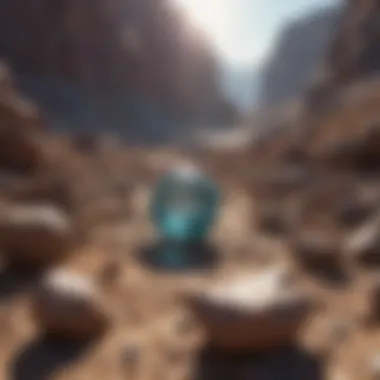Unveiling the Art of Gem Hunting: A Comprehensive Guide to Precious Discoveries


Rock and Fossil Identification
Gem hunting enthusiasts understand the importance of being able to identify different types of rocks and fossils accurately. Various types of rocks and fossils exist, each with distinct characteristics that set them apart. From igneous to sedimentary, and metamorphic rocks to fossils like trilobites or ammonites, the variety is vast. When identifying rocks, geodes, or fossils, experts look for specific features such as color, texture, hardness, and crystal patterns. Utilizing tools like magnifying loupes, streak plates, hardness picks, and UV lights can aid in the identification process, helping collectors differentiate between similar specimens.
Collecting Tips and Techniques
Success in gem hunting often hinges on employing effective collecting methods. Experienced collectors emphasize the importance of following best practices to ensure the preservation of specimens and maximize collecting output. Locating prime sites for collecting gems involves research and exploration, as geological features like active mines, exposed bedrock, or sediment deposits can be promising locations. Safely extracting specimens requires careful excavation techniques and tools such as rock hammers, chisels, and brushes to minimize damage while handling delicate specimens.
Preservation and Display
Preserving collected rocks, fossils, and gems is vital to maintain their integrity and value. Techniques like cleaning with mild detergents, sealing with conservators' wax, or stabilizing fragile specimens help prevent deterioration. Proper storage methods include using acid-free containers, desiccants to control humidity, and storing away from direct sunlight to avoid color fading or degradation. Displaying these treasures creatively enhances their aesthetic appeal; ideas like shadow boxes, floating frames, or custom mounts showcase specimens while protecting their longevity.
Geological Insights
Exploring the geological context of gems adds a layer of significance to the collection. Understanding key formations and processes that led to gem deposition provides insights into their origin. Recognizing the historical significance of gemstone discoveries unravels stories of human fascination and exploration throughout time. Notable discoveries, like the Cullinan diamond or the Burgess Shale fossil bed, stand as testaments to the remarkable finds that continue to shape our understanding of Earth's history.
Introduction to Gem Hunting
The Fascination with Gems
The allure of gems transcends mere monetary value; it speaks to a primal human fascination with the beauty and rarity of these geological marvels. Since ancient times, gems have been revered for their symbolism, healing properties, and even their alleged ability to bestow luck upon their wearers. Diamonds, rubies, emeralds, and sapphires hold a timeless appeal that extends beyond their physical characteristics; they embody a sense of luxury, sophistication, and enduring beauty. The process of gem hunting itself offers a thrilling adventure, blending elements of exploration, geology, and personal accomplishment, making each discovery truly exhilarating for enthusiasts. From the shimmering depths of caves to the hidden treasures buried in the earth's crust, the journey of gem hunting unveils the beauty and mystery of the natural world in a way that no other pursuit can match.
Understanding Gemology
Gemology, a crucial component of the captivating world of gem hunting, plays a pivotal role in this comprehensive guide. Understanding Gemology is essential for all aspiring gem hunters as it provides detailed insight into the characteristics, properties, and classifications of precious stones, enabling enthusiasts to make informed decisions during their expeditions. By delving into Gemology, individuals can differentiate between various gem types, identify valuable specimens, and grasp the nuances that define each gemstone. This section sheds light on the significance of Gemology in enhancing the gem hunting experience, offering a foundation of knowledge that is indispensable for rock and fossil collectors seeking to navigate this intriguing realm.
Exploring Gem Types
Minerals
Minerals, one of the fundamental categories in Gemology, merit special attention for their diverse compositions and geological significance. They contribute significantly to the overall spectrum of gem types, with distinctive characteristics such as crystalline structures, chemical compositions, and formation processes. Describing the geological diversity that minerals exhibit, this section outlines the allure of minerals as gemstones, highlighting their durability, luster, and versatility. Despite variations in hardness and rarity, minerals remain a favored choice for gem hunters due to their inherent beauty and geological uniqueness.
Crystals
Crystals, renowned for their aesthetic allure and metaphysical properties, are a captivating facet of Gemology that enchant gem enthusiasts worldwide. With symmetrical shapes, internal structures, and vibrant colors, crystals fascinate collectors seeking both visual appeal and esoteric energies. This section explores the allure of crystals as gemstones, emphasizing their spiritual connections, healing properties, and aesthetic appeal. Despite varying in clarity and geological origins, crystals continue to be a popular choice among rock and fossil collectors, adding a mystical charm to any gem collection.


Organic Gems
Organic gems present a fascinating intersection between nature and gemology, offering unique specimens that originate from living organisms. Amber, pearls, and coral are among the most sought-after organic gems, prized for their natural origins and organic beauty. Discussing the allure of organic gems, this section showcases their iridescent hues, organic textures, and biological significance. While organic gems may require special care and maintenance compared to minerals and crystals, their distinctiveness and ecological origins make them a prized addition to any rock and fossil collection.
Properties of Precious Stones
Color
Color, a defining attribute of precious stones, holds paramount importance in Gemology for its aesthetic appeal and rarity. The hues exhibited by gemstones signify their mineral composition and geological history, offering a kaleidoscope of tones that range from vibrant to subtle. Examining the significance of color in gemstone identification, this section elaborates on the role of color in determining a gem's value, authenticity, and appeal. While some gemstones derive their worth from vibrant hues, others command attention due to rare colorations, underscoring the importance of color in the world of gem hunting.
Clarity
Clarity, an essential factor in gem appraisal, influences the brilliance and visual appeal of precious stones, delineating their internal flaws and inclusions. Gemologists evaluate a gem's clarity based on its transparency, brilliance, and visible imperfections, which impact the gem's value and desirability. Unpacking the significance of clarity in gemstones, this section underscores the importance of clear, flawless specimens while appreciating the beauty and rarity of inclusions that lend character to certain gems. By understanding and assessing a gem's clarity, enthusiasts can discern quality specimens and make informed decisions during their gem hunting pursuits.
Cut
Cut, a critical aspect of gem processing, determines the final shape, proportions, and facets of a gemstone, enhancing its brilliance and light reflection. Gem cutters utilize precision techniques to craft gems in various shapes such as round, emerald, and princess cuts, optimizing the stone's beauty and optical properties. Exploring the artistry of gem cutting, this section highlights the meticulous craftsmanship involved in shaping rough stones into polished gems, accentuating their color and sparkle. While cut styles vary based on gem type and desired outcomes, a well-executed cut elevates a gem's beauty and allure, making it a prized possession for collectors and connoisseurs.
Carat Weight
Carat weight, a standardized measurement in gemology, quantifies a gemstone's mass and size, influencing its value and rarity. Larger carat weights often denote larger gem sizes, commanding higher prices due to their scarcity and visual impact. Delving into the significance of carat weight in gem evaluation, this section elucidates how weight affects a gem's overall value, highlighting the balance between size, clarity, and color in determining a gem's worth. While carat weight plays a crucial role in gem pricing, collectors also appreciate unique carat sizes for their individuality and presence, showcasing the diversity and richness of the gemstone world.
Choosing the Right Gem Hunting Location
In the elaborate realm of gem hunting, the significance of choosing the right location cannot be overstated. The selection of the hunting site plays a crucial role in determining the success of a gem hunting expedition. By carefully considering various factors related to the location, rock and fossil collectors can enhance their chances of discovering valuable gemstones.
Researching Geological Sites
Researching geological sites forms the bedrock of successful gem hunting endeavors. Understanding the geological makeup of an area provides crucial insights into the potential presence of gem deposits. By studying the geological history, formations, and strata of a location, enthusiasts can pinpoint areas likely to yield precious gems.
Factors Impacting Gem Deposits
Climate
Climate exerts a profound influence on the formation and preservation of gem deposits. The climatic conditions of a region over millions of years contribute to the creation of specific gem types. For instance, arid climates may be conducive to the development of certain crystals, while regions with high humidity levels may foster the growth of other gem varieties. Exploring the relationship between climate and gem formation enhances the understanding of where to search for particular gems.
Geological Processes


Geological processes such as tectonic movements, volcanic activities, and erosion significantly impact the distribution of gem deposits. The movement of tectonic plates can bring gem-bearing rocks close to the surface, making them accessible to gem hunters. Volcanic eruptions may introduce new minerals into the environment, leading to the formation of unique gemstones. By recognizing the role of geological processes, collectors can strategically target areas with geological events conducive to gem formation.
Mineral Composition
The mineral composition of a region dictates the types of gems that can be found. Different minerals present in the earth's crust give rise to a diverse range of gemstones. For instance, regions rich in quartz deposits may yield quartz crystals of varying colors and sizes. Understanding the mineral composition of a hunting location enables collectors to anticipate the types of gems they are likely to encounter. By tapping into the unique properties of different minerals, gem hunters can tailor their search efforts to maximize their chances of discovering prized gem specimens.
Essential Tools for Gem Hunting
In the fascinating world of gem hunting, having the right tools at your disposal is crucial for a successful and rewarding expedition. The topic of essential tools for gem hunting holds paramount importance in this guide. By delving into the specific elements, benefits, and considerations surrounding essential tools, enthusiasts and beginners alike gain valuable insights into the core requirements of gem hunting.
Basic Equipment
- Trowel: The trowel plays a vital role in the arsenal of a gem hunter. Its narrow and pointed blade facilitates the careful excavation of gems embedded in soil or rock. The key characteristic of a trowel lies in its versatility, allowing for precision in digging and extracting gems without causing damage. The trowel's ergonomic design and durability make it a popular choice among gem hunters for its efficiency and ease of use. Despite its effectiveness, one must be mindful of its sharp edge, which can pose a risk if not handled with caution.
- Pickaxe: When it comes to breaking through tough rock formations to uncover hidden gems, the pickaxe is indispensable. Its pointed tip and rugged construction enable gem hunters to chip away at rocks and navigate through challenging terrains with ease. The key characteristic of a pickaxe is its strength and impact, allowing for swift and effective extraction of gems from hard surfaces. While the pickaxe's utility is unquestionable, its weight and size could present challenges during extended expeditions.
- Sieve: A sieve proves to be a valuable asset in the gem hunter's toolkit, particularly when sifting through sediment or soil to locate small gemstones. The key characteristic of a sieve lies in its ability to separate gemstones from debris based on size, streamlining the identification process. Its versatility and portability make the sieve a popular choice for gem hunters seeking efficiency in their search. However, one must handle the sieve with care to avoid wear and tear that could impact its performance.
- Magnifying Loupe: Precision is key in identifying and evaluating gemstones accurately, making the magnifying loupe an essential tool for gem hunters. This handheld magnification device allows enthusiasts to closely inspect gemstone details such as color, clarity, and inclusions. The key characteristic of a magnifying loupe is its ability to provide magnification ranging from 10x to 30x, enhancing the clarity of gem features. While the magnifying loupe's compact size and functionality make it a popular choice, users need to ensure proper maintenance to prevent scratches on the lens that could affect visibility.
Advanced Gear
- Metal Detector: In the realm of advanced gear for gem hunting, the metal detector emerges as a game-changer for enthusiasts seeking to enhance their treasure-hunting capabilities. Its ability to locate metallic minerals and gems hidden beneath the earth's surface offers a significant advantage in pinpointing valuable finds. The key characteristic of a metal detector lies in its sensitivity settings and discrimination features, allowing users to filter out unwanted materials and focus on valuable targets. While the metal detector accelerates the search process, users must familiarize themselves with its operation to maximize its efficiency and target selection.
- UV Light: Unveiling the hidden fluorescence of certain gems, UV light serves as a remarkable tool in gem hunting expeditions. Its ability to reveal unique patterns and colors in gemstones under ultraviolet illumination adds an exciting dimension to the identification process. The key characteristic of UV light is its spectrum range, including longwave and shortwave UV, each highlighting specific gem properties. While UV light enhances the detection of fluorescent gems, users should exercise caution and wear protective eyewear to prevent exposure to harmful UV rays.
Techniques for Gem Identification
In the intriguing world of gem hunting, the techniques for gem identification play a pivotal role in distinguishing between various gem types, ensuring authenticity, and appraising their value accurately. Understanding these techniques is essential for gem enthusiasts and collectors, as it allows them to make informed decisions regarding their finds.
These gem identification techniques encompass a range of methods such as visual examination, gemological testing, and use of specialized equipment. Visual examination, in particular, serves as the initial step in identifying gems, focusing on observable characteristics like color, transparency, and overall appearance. This method provides valuable insights into the gem's potential type and quality, serving as a foundation for further analysis.
By mastering the art of visual examination, gem hunters can differentiate between minerals, crystals, and organic gems based on their distinct visual features. Color, one of the primary aspects considered during visual examination, offers clues about the gem's composition and potential rarity. Clarity, another crucial factor, determines the presence of any inclusions or imperfections that impact the gem's value.
Moreover, the cut of a gemstone plays a significant role in its visual appeal and sparkle, affecting its brilliance and overall beauty. Gemologists also rely on carat weight as an indicator of size and value, using precise measurements to classify gems accurately. By honing their skills in visual examination, gem hunters can unlock the secrets hidden within each gemstone they encounter, enriching their exploration and collection.
Visual Examination
Visual examination stands as a fundamental aspect of gem identification, offering valuable insights into a gem's characteristics and quality. By meticulously observing the color, clarity, cut, and carat weight of a gemstone, gem hunters can make informed decisions about its value and authenticity.
Color, the most noticeable feature of a gemstone, reflects its unique composition and origin, influencing its rarity and desirability in the market. Gemologists analyze the hue, tone, and saturation of the color to determine the gem's classification and quality. Clarity assessment involves examining the presence of inclusions, fractures, or blemishes within the gem, affecting its transparency and overall visual appeal.
The cut of a gemstone plays a crucial role in enhancing its brilliance, fire, and scintillation, showcasing the lapidary skills employed in shaping the gem. Gem hunters closely inspect the cut proportions, symmetry, and polish to assess the stone's aesthetic beauty and light performance. Carat weight serves as a standardized unit of measuring a gem's size, with one carat equivalent to 200 milligrams.


Effective visual examination requires patience, precision, and a keen eye for detail, allowing gem hunters to appreciate the unique characteristics of each gemstone they encounter. By mastering this technique, enthusiasts can confidently separate genuine gems from imitations, enriching their gem hunting experiences with a deeper understanding of the treasures hidden beneath the earth's surface.
Ethical and Legal Considerations
In the realm of gem hunting, Ethical and Legal Considerations play a pivotal role in ensuring the sustainability and responsibility of this practice. It is imperative to act ethically and adhere to legal regulations to protect both the environment and cultural heritage. By addressing ethical considerations, gem hunters contribute to preserving the natural beauty of the areas they explore and respecting the communities that might be impacted by their activities. Furthermore, compliance with mining regulations not only safeguards the environment but also upholds the integrity of the gem hunting industry. These considerations help maintain the equilibrium between the thrill of discovery and the responsibility towards nature and society.
Protecting the Environment
Protecting the environment is a non-negotiable aspect of gem hunting ethics. Gem hunters must be vigilant in minimizing their ecological footprint by avoiding habitat destruction, pollution, and disturbance of wildlife. Utilizing sustainable practices and following designated paths can significantly reduce the environmental impact of gem hunting activities. Moreover, raising awareness about the importance of environmental conservation within the gem hunting community can foster a culture of responsible and eco-conscious behavior. By safeguarding the ecosystems in which they operate, gem hunters can ensure the longevity of their pursuits for future generations.
Adhering to Mining Regulations
Adhering to mining regulations is crucial for maintaining the integrity of gem hunting operations. By following established guidelines and obtaining necessary permits, gem hunters contribute to the sustainable management of mineral resources. Compliance with mining laws also aids in the prevention of irresponsible mining practices that can lead to environmental degradation and legal repercussions. Understanding and adhering to regulations related to land use, extraction methods, and property rights not only instills professionalism in gem hunting endeavors but also fosters trust and cooperation with authorities and local communities. By upholding ethical standards and legal requirements, gem hunters demonstrate their commitment to responsible stewardship of natural resources.
Preserving and Displaying Your Gem Finds
Preserving and Displaying Your Gem Finds is a crucial aspect of the gem hunting journey outlined in this comprehensive guide. As avid rock and fossil collectors delve into the excitement of uncovering precious gems, it becomes essential to ensure the longevity and aesthetics of their findings through proper preservation and attractive display. This section shines a spotlight on the significance of preserving and flaunting your gem discoveries.
When it comes to gems, their beauty is timeless, but their physical condition requires maintenance to retain their allure. Cleaning and Storing Gems play a pivotal role in this preservation process. Ensuring that gems are free from dirt, oils, and other particles maintains their brilliance and luster. Proper storage techniques protect the gems from scratches, chips, or exposure to damaging environmental factors. Rock and fossil collectors embarking on gem hunting expeditions must acknowledge the delicate nature of these treasures and prioritize their care to uphold their value and beauty.
In addition to preservation, [Showcasing Your Collection] serves as a testament to the dedication and passion invested in gem hunting. Constructing an appealing display for gem finds not only accentuates their beauty but also allows collectors to share their discoveries with others. Whether creating a personal exhibit in a dedicated space or curating a collection for public viewing, showcasing gems showcases the collector's discernment and appreciation for the earth's natural wonders. Highlighting the uniqueness and rarity of each gem elevates the collector's experience, transforming a personal hobby into an artful endeavor that resonates with enthusiasts and connoisseurs alike.
Future Prospects in Gem Hunting
As we traverse the realm of gem hunting in this meticulously crafted guide, it is imperative to shed light on the pivotal section - Future Prospects in Gem Hunting. This segment serves as a beacon illuminating the path forward for enthusiasts and professionals alike, offering a glimpse into the evolving landscape of gemology.
Diving deep into the significance of exploring Future Prospects in Gem Hunting within the context of this comprehensive article unveils essential foresight into upcoming trends, innovations, and opportunities within the field. By scrutinizing future prospects, readers can grasp the trajectory of gem hunting, preparing themselves for what lies ahead.
Highlighting the dynamic nature of gemology, this section delves into specific elements poised to shape the future of gem hunting. From cutting-edge technologies revolutionizing gem identification to sustainability practices transforming the ethical landscape of mining, each aspect contributes to painting a vivid picture of what tomorrow holds for gem hunters.
Moreover, understanding the benefits linked to Future Prospects in Gem Hunting proves instrumental in fostering a forward-thinking approach among gem enthusiasts. By staying abreast of emerging techniques and industry developments, individuals can elevate their gem hunting prowess, staying ahead in a competitive arena where innovation reigns supreme.
Considering the importance of Future Prospects in Gem Hunting underscores the need for readers to contemplate various considerations as they navigate the ever-evolving gemology field. Factors such as market trends, environmental impact awareness, and regulatory shifts play a pivotal role in shaping the future landscape of gem hunting, urging enthusiasts to adapt and innovate in tandem with the industry's trajectory.
Advancements in Gemology
Within the expansive realm of gemology lies a realm of innovation and progress embodied by Advancements in Gemology. This subsection encapsulates the cutting-edge developments and breakthroughs propelling the field forward, offering a glimpse into the transformative technologies revolutionizing gem identification and extraction.
Unveiling the intricate web of Advancements in Gemology within this article paves the way for readers to delve into the heart of technological evolution within the gem hunting domain. From the advent of spectroscopy enhancing gemstone analysis to the utilization of 3D imaging for precision gem cutting, each advancement breathes new life into traditional practices, amplifying efficiency and accuracy in the gem hunting process.
Exploring the nuances of Advancements in Gemology not only enriches readers' understanding of the field's intricacies but also underscores the significance of embracing innovation in a landscape defined by constant evolution. By embracing technological progress and scientific breakthroughs, gem hunters can unlock new realms of possibility, elevating their craft and staying at the forefront of a swiftly evolving industry.
Pioneering advancements in gemology accentuate the profound impact of research and development on the gem hunting experience, offering enthusiasts and professionals alike a myriad of tools and resources to enhance their practice. Through a lens of continuous improvement and innovation, the future of gemology shines brightly, beckoning forth a new era of exploration and discovery.







